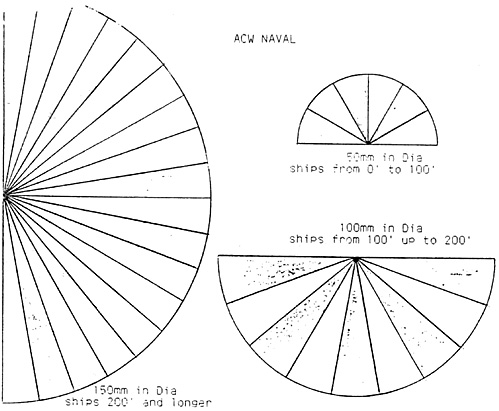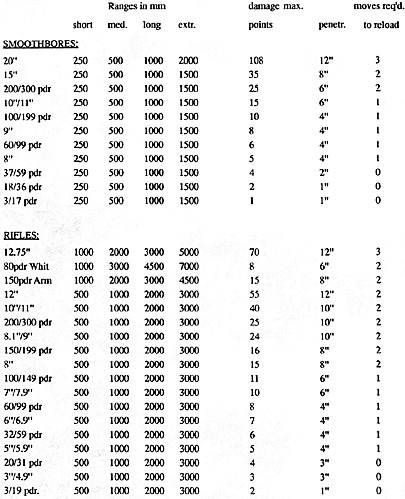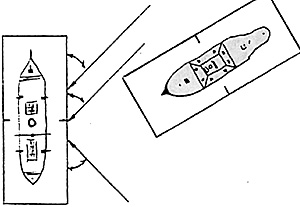Introduction
The American Civil War was fought on both land and sea. The land fighting was by far the most important. However, the naval blockade and eventual capture of the main Confederate ports by the Union Navy contributed greatly to the final defeat of the South.
Considering that the Confederacy had no warships at the start of the war, it is to their credit that they put up such a good show against the more numerous and better equipped Northern foe. There were few naval engagements in the true sense of the word, as most were fought on rivers, near the mouths of rivers, or at the entrances to ports. To take account of the above facts, fort guns, mines, etc., are all included in the rules to allow the use of land defenses.
Recommended Reading:
Arms and Equipment of the Civil War by Jack Coggins
Battles and Leaders of the Civil War (four vol.) by various authors
Availability of Model Ships: Navwar, Fleetline, and R.T. Houston all produce excellent 1/1200 scale ships.
EQUIPMENT:
You will need model ships, metric tape measure or ruler, terrain (if necessary), and one twenty sided die numbered 1 through 20.
SCALES:
Ground Scale: 50mm = 100 yards
Movement Scale: 20 mm = 1 knot
Time Scale: 1 turn = approx. 2 minutes
 Ship Bases: To facilitate movement and firing, I would suggest mounting the ship models on bases made of stiff cardboard or wood, and mark them as shown, since this aids the maneuvering of the models (all sizes are in millimeters).
Ship Bases: To facilitate movement and firing, I would suggest mounting the ship models on bases made of stiff cardboard or wood, and mark them as shown, since this aids the maneuvering of the models (all sizes are in millimeters).
A mark is made halfway down the length on each side of the base as shown to aid turning of the ships.
Ship Point Values: The point value of a ship represents the amount of damage points that the vessel can sustain before it becomes a total wreck. (Usually the use of displacement in tons is utilized to derive ship point values in naval rules. However, such information on vessels of this period is not always accurate or available. I therefore decided on the following method to determine the point value of the various ships.)
Using the dimensions of the ship, work out the following calculation to determine a basic point value (BPV) for the ship:
- BPV=(length x beam x draft) divided by 200
Note: All dimensions are in feet.
2) Now the BPV is modified for the vessel's armor (if any). Use only the average armor backing thickness for this calculation:
- +25 points for each 1/2" of metal armor
 +5 points for each 1" of wood or cotton armor or backing
+5 points for each 1" of wood or cotton armor or backingIncrease the armor points total by 50% if the vessel's casemate sides are sloped more than 30 degrees from vertical OR if the ship has gun turrets.
ORDER OF PLAY EACH MOVE:
Both sides move and fire simultaneously. Follow the sequence below and you should have no problems.
1) Attempt to extinguish fires, repair damage, etc.
2) Write move orders for each ship. Example: A plot of "1 -2P-3" means this ship will move 1 knot forward, then turn 2 knots to port, and then 3 knots forward.
3) Move ships in accordance with written orders in 2) above.
4) Calculate the effect of ramming and torpedoes.
5) Fire all guns that may fire and record all damage points inflicted.
6) Perform special effects if required or necessary.
MOVEMENT:
1) All ships may move at any speed permitted, as long as its maximum speed is not exceeded.
2) A ship may increase or decrease its speed by up to 2 knots per move.
3)A ship may travel in reverse at a speed up to 1/2 its maximum forward speed unless the vessel is double-ended, in which case it can move at its maximum forward speed in either direction.
4) Ships turn by using a turning semi-circle made of stiff cardboard, the diameter of which depends on the size of the turning ship. Each segment on the turning gauge represents 1 knot of movement for the ship. The segments vary depending on the size of ship as shown in the diagrams. Ships may turn up to their full move if desired.

FIRING:
Follow this procedure when firing guns.
1) Measure the range from the center of the firing ship to the center of the target ship. Non-turret and non-pivot guns have an arc of fire of 10 degrees left or right.
2) Consult the Gun Table to determine if the range is extreme, long, medium, or short.
3) Consult the Hit Table, add or subtract any relevant hit factors, and throw one die. If the modified die score is equal to or greater than the hit number required, then the shot has hit the target ship.
4) Check to see if the target's armor has been penetrated.
5) Determine the damage points inflicted by the hit.
6) If the shot penetrated the target's armor, roll the die and consult the Special Effects Table. Roll on this table each time a penetrating hit occurs.
GUN TABLE:
In the Gun Table are listed the ranges, damage points inflicted, maximum penetration of metal armor which a gun is capable of, and also the minimum time required to reload the gun. Many of the large calibre guns included in the table were practical only for use as fortress guns. These have been included to allow the use of forts as previously mentioned.

Notes on table: Penetration of shot is reduced by 1" per 500mm of range for rifles and 1" per 250mm of range for smootbbores. Damage points are doubled if shot penetrates ships' armor (therefore ships with no metal armor will always suffer double damage points when hit).
WORKING OUT HITS The procedure is as follows. Consult the hit table, then add or subtract the relevant hit factors and roll the die. If the score is equal to or greater than the required hit number, a hit has been made on the target.
HIT TABLE
| Hit Factors | Range: Hit number required | |||
|---|---|---|---|---|
| Short 12 | Med. 15 | Long 18 | Extr. 20 | |
| Target speed is 10 knots or more +2 | ||||
| Target speed is more than 5 knots but less than 10 knots +1 | ||||
| Target is stationary -1 | ||||
| Target ships' length is 200' or more -1 | ||||
| Target ships' length is under 100' + 1 | ||||
| Vessel firing guns is on fire +2 | ||||
SPECIAL EFFECTS:
If a shot penetrates the target's armor, roll a die and consult the special effects table. If the effect roiled has no relevance to the ship concerned, then treat it as a no effect result. Example: ships with no turret cannot suffer a turret hit, therefore this becomes a no effect result.
Special Effects Table
Die Roll: Special Effect
1 or 2 The hit causes a fire to start. Each hit that causes a fire inflicts 10% points of damage at the end of each move that it is still burning. At the start of each move the crew may attempt to extinguish each fire on the ship. A die roll of 11-20 puts out a fire. Each fire must be extinguished separately with a die roil.
3 Engine destroyed, ship stops dead in the water.
4 Rudder hit. Ship may not turn to port (left) again during this battle.
5 Rudder hit. Ship may not turn to starboard (right) during this battle.
6 or 7 One non-turret gun is destroyed. If ship has more than one gun remaining, use die roll to randomly select the destroyed gun.
8 or 9 Turret hit. Throw the die again. Any score from 1 to 10 results in the turret gun being damaged and unserviceable. Any score from 11 to 20 results in the turret being broken and it will not turn again, however its guns may continue to fire. If the vessel has more than one turret, use a die roll to randomly determine the effected turret.
10 Pilot killed, ship continues on present course for next 2 moves.
11 Stern paddle wheel hit. Ship stops dead in the water.
12 Side paddle wheel hit. Roll die again, 1-10=port wheel, 11-20= stbd. wheel lost. Max. speed reduced by 50% and vessel can only turn in the direction of the lost wheel.
13 or 14 No effect
15 or 16 Sailing ships' masts are destroyed. Movement bonus for using sails with steam is lost.
17 or 18 Boiler hit. The ship is filled with steam and crew may not reload or fire enclosed guns for the next two moves. Maximum speed reduced by 50% (speed reductions are cumulative).
19 Engine hit. max speed reduced by 50%. Engines may be repaired .Roll a die at the start of each move, a score of 16 to 20 results in the damage being repaired Remember , all speed reductions are cumulative.
20 Magazine hit roll a die. A score of 1-5=explosion & ship sinks, 6-10=partial explosion causing 50% of the original points in damage with all guns and engine being disable, 11-20=a partial explosion causing 25% of the ships' original points in damage.
TORPEDOES:
Spar torpedoes were used with devastating effect by both sides during the war. A spar torpedo may only be used once even if it fails to explode. When a spar torpedo hits its target, roll the die and consult the table below.
Die Roll Resulting Points of Damage
- 1-4 Torpedo fails to explode
5-8 100
9-12 200
13-16 300
17-18 400
19-20 Target sinks
MINES:
Mines were used with amazing success by the Confederates.They were made in various shapes and sizes and were operated in several different ways. Use the following method to simulate minefields and their effects. Mark out clearly the area of the minefield on the playing surface. Roll a die for each vessel each move that it enters, moves through, or exits the minefield. A die roll of 1 to 3 results in the ship striking a mine and sinking.
RAMMING:
A ramming occurs when two ships come into base to base contact. For a ramming to have an effect, the ramming ship must hit its target within 45 degrees of either side of a line perpendicular to the target ship's side as shown in the diagram below. If this condition is not met, then the ships steam past one another without inflicting serious damage. The effect of ramming is worked out as follows.
A) Ramming with a strengthened bow: damage to target = (2 x closing speed x original point value) divided by 100
Also, throw a die. A result of 16 to 20 indicates that the ramming ship's bow is damaged and will in any future rams be counted as an ordinary how.
B) Ramming with an ordinary bow:
 The procedure here is the same as shown above except that the ramming vessel also suffers 1/2 the damage points that it inflicted on the target. No die roll is necessary here.
The procedure here is the same as shown above except that the ramming vessel also suffers 1/2 the damage points that it inflicted on the target. No die roll is necessary here.
SHIPS RUNNING AGROUND:
If a ship attempts to enter water that is shallower than its draft, it runs aground. A vessel that is aground may attempt to re- float at the start of each move. Roll a die. A score of 16 to 20 means that the attempt has been successful, otherwise it remains aground. Other ships may attempt to tow a vessel that has run aground to deeper water.
TOWING SHIPS:
Ships towing other ships have their maximum speed reduced by 50% while so doing. It takes one complete move while stationary to set up a tow.
FORTS:
Forts and land defenses should be assigned a point value at the start of the game. Each shot that hits a fort inflicts the same damage as if it were hitting an unarmored ship. Each hit also has a chance of silencing a gun and this should be done randomly. Once a fort has lost its original point value, it takes no further part in the battle and the garrison withdraws to a safer position if possible, if not it surrenders.
Back to The Zouave Vol IV No. 3 Table of Contents
Back to The Zouave List of Issues
Back to Master Magazine List
© Copyright 1990 The American Civil War Society
This article appears in MagWeb (Magazine Web) on the Internet World Wide Web.
Other military history articles and gaming articles are available at http://www.magweb.com